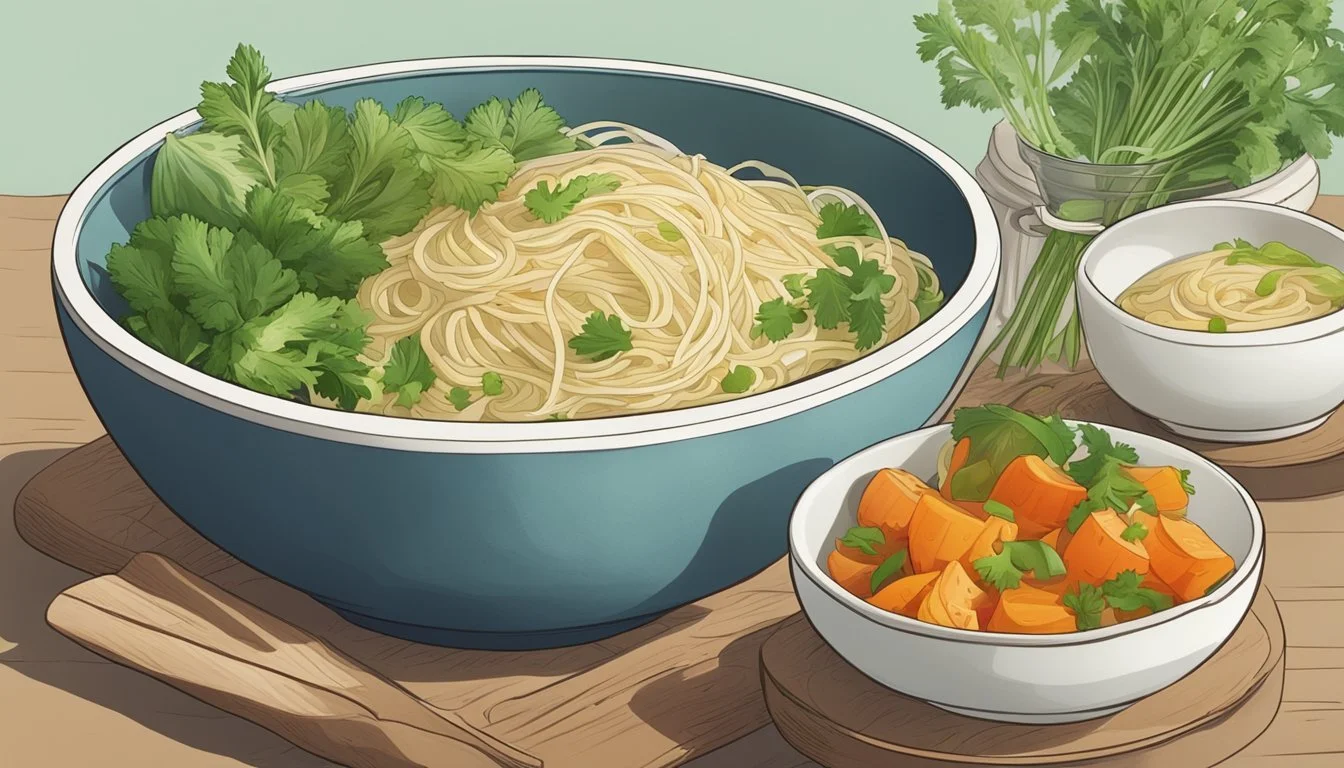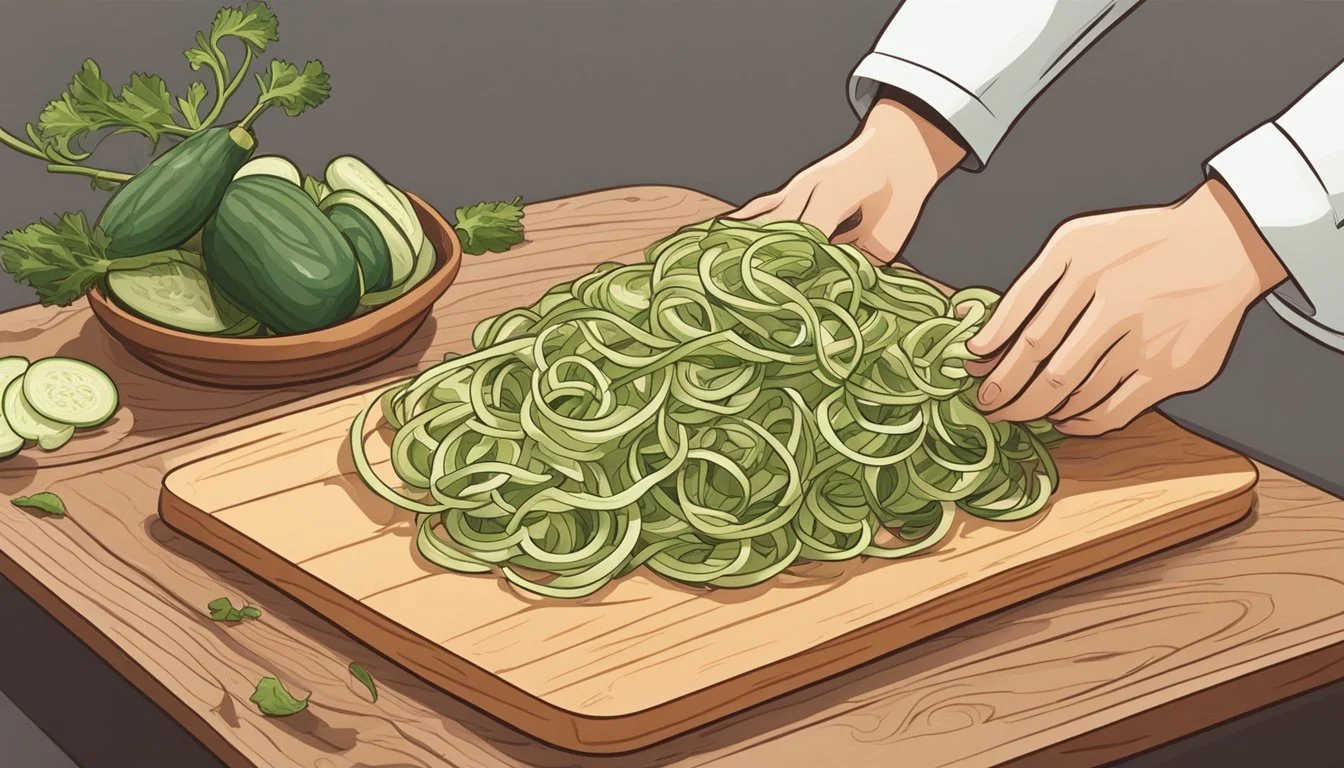Celeriac Noodle Substitutes
Top Alternatives for Low-Carb Pasta Options
Celeriac, also known as celery root, is a versatile root vegetable appreciated for its unique flavor and texture, especially when transformed into noodles for various dishes. However, due to its distinct taste and not always being readily available at every market, cooks might seek alternatives that can simulate the texture and complement the flavors of traditional celeriac-based noodle dishes. Substituting celeriac effectively requires understanding both its role in a dish and finding a replacement that maintains the integrity of the original recipe.
Several root vegetables and other ingredients can step in as celeriac noodle substitutes without compromising the dish's taste and presentation. Parsnips, with their earthy taste, can be used in much the same way as celeriac, offering a similar texture which is particularly fitting for soups and stews. Another option, the daikon radish, provides a different flavor profile; it can be eaten raw or cooked and, when prepared as noodles, adds a pleasantly mild peppery taste to salads or can be used as an alternative in cooked recipes.
Potatoes are a readily available substitute and, given their neutral flavor, can be used to replace celeriac in a pinch, especially when seasoned appropriately. Their starchy consistency allows them to hold their shape well when cut into noodles, making them a convenient and adaptable choice for a variety of dishes. In the search for celeriac noodle substitutes, these alternatives allow for culinary adaptability without sacrificing the quality and enjoyment of the meal.
Understanding Celeriac
Celeriac, also known as celery root, is a root vegetable often used for its distinctive flavor and versatility in cooking. It is a low-starch alternative to other root vegetables and is prized for its nutritional benefits.
Celeriac Nutrition Profile
Celeriac is rich in dietary fiber which aids in digestion. It also contains vitamin C and vitamin K, both essential for the body's immune system and bone health. Additionally, celeriac provides a range of minerals, including potassium, magnesium, and phosphorus.
Nutrition Table:
Nutrient Amount per 100g Dietary Fiber ~3g Vitamin C 8% of DV Vitamin K 41% of DV Potassium ~300mg Magnesium ~20mg
Celeriac Culinary Uses
Celeriac is widely used in culinary dishes, ranging from raw salads to heartier cooked fare. It is often utilized to create a flavorful celeriac gratin or adds a subtle, earthy note to soups. Its texture allows it to be turned into noodles, offering a low-carbohydrate option for pasta-like dishes.
Culinary Uses List:
Raw: In salads for a fresh, crunchy texture
Cooked: In soups, stews, and celeriac gratin
Substitute: For pasta as celeriac noodles in various recipes
Celeriac Availability
Celeriac is generally available at most grocery stores throughout the year in the produce section. While it may not be as common as other root vegetables, its availability has increased due to its growing popularity among health-conscious consumers and chefs alike.
Availability Points:
Produce Section: Found in the fresh produce aisle
Year-Round: Typically available all year
Specialty Stores: More common at stores with a larger selection of produce
Why Substitute Celeriac?
Celeriac, also known as celery root, is a versatile ingredient with a unique flavor and texture. However, individuals may seek substitutes for various reasons such as dietary restrictions, specific texture and flavor preferences, or due to its seasonal availability.
Dietary Restrictions
For those with allergies to celeriac or looking to adhere to dietary needs, finding a suitable alternative is paramount. Substitutes like parsnip and carrots offer similar textures and can be more easily integrated into a gluten-free or low-carb diet. One must ensure that the alternate vegetable aligns with their dietary requirements, whether they are avoiding certain allergens or seeking a vegetable that does not disrupt dietary goals.
Allergies: Choose non-reactive vegetables like parsnips or carrots.
Low-Carb: Opt for vegetables like daikon radish that are lower in carbohydrates.
Gluten-Free: Most root vegetables are naturally gluten-free, making them safe alternatives.
Texture and Flavor Preferences
The unique crunchy texture and earthy flavor of celeriac might not align with everyone's taste preferences. Substitutes are sought to match the desired texture and taste profile in dishes such as salads or stir-fries. For instance, for a milder flavor, one could opt for daikon radish, while for a softer, sweeter alternative, parsnips or white carrots could be chosen.
Milder Flavor: Daikon radish offers a less pronounced taste.
Crunchy Texture: Carrots maintain a satisfying crunch either raw or cooked.
Seasonal Availability
Celeriac is a seasonal produce, typically found in the produce section during specific months of the year. When out of season, individuals turn to other various root vegetables that can be available year-round. These alternatives may not be exact replicas in flavor but serve well as substitutes because of the similar ways they can be used in cooking.
Year-Round Alternatives: Kohlrabi and celery seed are commonly found throughout the year.
Similar Usage: Alternatives should be versatile enough for raw or cooked applications, such as daikon radish or kohlrabi.
Popular Celeriac Substitutes
This section explores various alternatives to celeriac noodles, ranging from other root vegetables to low-carb options, offering a diverse palette of flavors and textures to complement different dishes.
Root Vegetable Alternatives
Root vegetables commonly stand in for celeriac due to their similar textures and ability to absorb flavors. Parsnips are a top choice, featuring an earthy taste that enriches soups and stews. Turnips and rutabagas provide a peppery kick, excellent for roasted dishes, while carrots impart a naturally sweet taste. Daikon radish is another option, suitable for both cooked and raw preparations.
Squash Varieties
Squash can serve as a flavorful and vibrant substitute for celeriac noodles. Butternut squash brings a nutty and sweet taste to the plate, while pumpkin can offer a rich, creamy texture. Spaghetti squash, with its distinctive strands, can be a direct noodle substitute that holds sauces well, making it ideal for casserole and pasta-like dishes.
Starchy Vegetable Options
For those favoring a starchy mouthfeel, sweet potatoes are a nutritious substitute providing a sweet and hearty dimension to dishes. Potatoes themselves, with their versatile nature, can mimic the bulk of celeriac in recipes, suitable for boiling, mashing, or even spiralizing into noodles.
Low-Carb and Pasta Substitutes
Those seeking a lower-carbohydrate alternative may gravitate towards shirataki noodles, made from the konjac plant. They are almost zero calories and carbs, with a gelatinous texture. Zucchini can be spiralized into 'zoodles', an excellent noodle substitute for pasta dishes. Similarly, cucumbers can be used in cold salads for a crisp texture. For something closer to grain, rice, particularly cauliflower rice, can substitute for celeriac to reduce carbs without compromising the dish's integrity.
Celeriac Substitutes in Cooking
When celeriac is unavailable or when you're looking to try something different, there are a number of substitutes that can be used in a variety of dishes to achieve similar textures and flavors.
Substitutes for Celeriac in Soups and Stews
Soups and stews often benefit from the distinct flavor and texture that root vegetables add. If celeriac is not an option, parsnips and turnips are excellent replacements. They maintain a comparable texture and impart an earthy tone to the dish.
Parsnips: A sweet and nutty taste, perfect for pureed soups.
Turnips: A slightly peppery edge, ideal for hearty stews.
Substitutes for Celeriac in Salads
In salads, celeriac's crisp texture and mild flavor is a desired component. Should celeriac be missing from your pantry, jicama or fennel bulb can stand in:
Jicama: Adds a sweet and nutty crunch.
Fennel bulb: Offers a licorice-like taste with a crisp texture.
Substitutes for Celeriac in Mashes and Gratins
For creamy mashes and rich gratins, where celeriac lends its starchy body and nuanced taste, you might consider these alternatives:
Potatoes: Provide a fluffy texture and absorb flavors well.
Cauliflower: Delivers a lighter, yet creamy consistency, often used for a healthier twist.
Substitutes for Baked or Roasted Celeriac
In baked or roasted dishes, such as vegetable medleys or as a stand-in for pasta in lasagna, celeriac's firmness is key. When another option is needed, the following are suitable:
Carrots: Their natural sweetness intensifies when roasted.
Rutabaga: Stands up well to roasting and offers a slight bitterness that complements other flavors.
Eggplant: A meaty texture that makes it a good substitute in layered dishes like lasagna.
Health and Nutritional Considerations
When selecting a celeriac noodle substitute, one should consider not only taste and texture but also the health and nutritional implications. The fiber and vitamin content, carbohydrate levels, and potential allergens must be assessed to meet dietary needs and preferences.
Comparing Fiber and Vitamin Content
Celeriac is known for its high fiber content, which is essential for digestive health. Substitutes like parsnip and turnip provide similar fiber levels, which can help maintain this nutritional benefit. These vegetables are also rich in vitamins. Celeriac and its substitutes often offer good amounts of vitamin C and vitamin K, essential for immune function and bone health, respectively.
Substitute Fiber (per 100g) Vitamin C Vitamin K Celeriac 1.8g 8mg 41µg Parsnip 4.9g 17mg 22.5µg Turnip 2.8g 21mg 0.1µg
Low-Carbohydrate Alternatives
For those following a low-carb diet, it's important to consider the carbohydrate content of celeriac substitutes. Daikon radish and cabbage serve as excellent low-carbohydrate alternatives. Cabbage, for instance, contains approximately 6 grams of carbs per 100 grams and is quite low in calories. This makes it an attractive option for weight management and diabetes control.
Allergies and Food Sensitivities
For individuals with allergies or food sensitivities, it is crucial to select a substitute that does not trigger adverse reactions. While celeriac itself is a common allergen, many of its substitutes like parsnip or daikon radish typically do not elicit the same responses. However, always consult with a healthcare professional or dietitian when dealing with severe allergies or sensitivities to ensure the chosen substitute is safe for consumption.
Selecting the Best Substitute
When looking to replace celeriac noodles in a recipe, one must consider not only taste but also how texture and cooking methods can affect the outcome of the dish.
Considering Texture and Consistency
The key to a successful substitute lies in mirroring the firm yet flexible texture of celeriac noodles. Parsnips can be an excellent stand-in, as they offer a comparable dense texture which holds up well when spiralized into noodle shapes. Additionally, one must consider how alternatives like parsnips will mash under pressure compared to celeriac to ensure a similar bite in the final dish.
Balancing Flavors
Celeriac has a unique taste that is both earthy and slightly sweet. Alternatives should complement these flavors without overwhelming them. Parsnips bring a sweet taste that can balance many dishes, while jicama provides a refreshing crunch with a milder flavor profile. For recipes requiring a more peppery zest, turnips and rutabagas can be ideal, imparting a bit of a bite that resonates well in robust savory meals.
Adapting to Cooking Methods
It's crucial that substitutes for celeriac noodles don’t fall apart or become mushy with the intended cooking technique. Parsnips excel in a variety of methods, including baking, roasting, and boiling, making them a versatile choice. If the method involves raw applications, using jicama is preferred as it retains a crunchy texture even without cooking. When selecting an alternative, always consider how the cooking process will change the texture and overall integrity of the noodle substitute.
Final Thoughts
When cooking with celeriac noodles, one must consider texture, flavor, and compatibility with other ingredients. Though unique, celeriac's slightly nutty and earthy flavor can be replicated with thoughtful substitutes.
Parsnip stands out as a reliable alternative, offering a similar earthiness. Cut into thin strips, parsnips offer a hearty bite which stands up to cooking, very much akin to the beloved celeriac noodle.
Carrots, with their natural sweetness, can be spiralized to mimic the shape and texture of celeriac noodles. They hold their form well, offering a slight crunch with a colorful visual appeal.
For those seeking a more neutral taste, Daikon radish might be the ideal celeriac substitute. This Asian root vegetable is easily transformed into noodles that absorb accompanying flavors while providing a crisp texture.
Substitute Comparison:
Parsnip: Earthy, holds well during cooking
Carrots: Sweet, adds color and crunch
Daikon Radish: Neutral, absorbs flavors from sauces and seasoning
Choosing a substitute for celeriac noodles doesn't have to be a compromise. Rather, cooks can see this as an opportunity to explore alternate flavors and textures while still achieving the desired outcome in the dish they are preparing.
In essence, each celeriac substitute brings its own merits to the table. It allows chefs and home cooks alike to adapt their recipes based on availability, personal taste preferences, and desired presentation.







